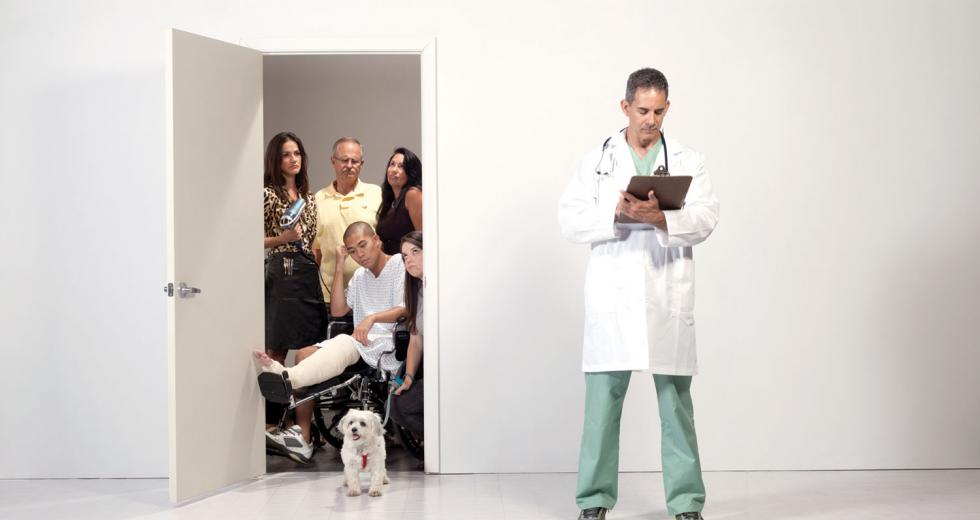Under the federal Affordable Care Act, all but a small number of
Americans soon will be required to have health insurance. But
having insurance is one thing; getting the medical care it is
intended to cover may be entirely another.
Current estimates show California has about 8 million uninsured
residents. More than 6 million of them are expected to obtain
coverage by the ACA deadline of January 2014. Possibly more than
2 million will get coverage under Medi-Cal, the state/federal
health care plan for the poor. But with California and the nation
facing significant physician shortages, many Capital Region
medical providers wonder if the expected flood of new patients
will even be able to find doctors.
“Theoretically, many of these uninsured people will eventually have health insurance,” says Sarah Krevans, president of Sutter Health’s Sacramento Sierra Region. “But health insurance is not health care access.”
And for all its best intentions, the Affordable Care Act may make that access even tougher to come by.
“There are already physician shortages that will undoubtedly be exacerbated by the ACA’s expanded insurance coverage,” says Claire Pomeroy, CEO of the UC Davis Health System and dean of the university’s medical school. “The shortfalls are particularly acute in regard to primary care providers, but locally we already have issues with access to both primary care and specialty providers.”
The threat of physician shortages is not new. The Association of American Medical Colleges reports that the U.S. was predicted to face a shortfall of more than 39,000 physicians by 2015 — and that was before the ACA was signed into law in March 2010. Since then, the estimated shortfall has increased to more than 63,000 by 2015 and 130,000 by 2025. The impact could be particularly hard on California, which a 2004 UC study predicted will experience a shortage of at least 17,000 doctors by 2015.
“The shortfalls are particularly acute in regard to primary care providers, but locally we already have issues with access to both primary care and specialty providers.”
Claire Pomeroy, CEO, UC Davis Health System, and dean, UC Davis School of Medicine
But accurately assessing California’s specific situation is always a little sketchy. Data from the Medical Board of California shows that as of 2008 approximately 119,000 doctors were licensed to practice in the state. The California Health Foundation also notes the state’s supply of physicians has grown faster than the overall population since 1998, about 7 percent in all.
That sounds good, but Lisa Folberg, vice president of medical and regulatory policy for the California Medical Association, argues those figures are deceiving. Case in point: Of the 119,000 physicians noted in the 2008 medical board data, Folberg says barely 99,000 were practicing in California. By 2010, the total number of licensees had climbed to more than 122,000, but the number of doctors working in California had dropped by 500.
“We have to be really cautious to not just be counting heads,” Folberg says. “These figures don’t take into account the number of currently licensed physicians that are actually retired, or who are working only part time or who are working in administration for a hospital or medical group or in academia. Given that, we estimate there are around 70,000 to 75,000 physicians active in full-time practice and taking patients.”
To add to the confusion, similar data accumulated by the American
Medical Association places the raw numbers much higher, which the
California Health Foundation ascribes to errors in the AMA’s
methodology.
The medical board data also indicates only 34 percent of the
state’s licensed doctors are the general practitioners patients
usually see first for most ailments. Even when accounting for
osteopathic physicians, it still shakes out to only about 63
primary care doctors for every 100,000 residents. That is barely
within the low end of the 60 to 80 physicians generally
recommended per 100,000 patients by the Council on Graduate
Medical Education, which reports on such matters to Congress and
the U.S. Secretary of Health and Human Services. Conversely,
California has roughly 115 specialists per 100,000 residents,
many more than the 80 to 105 the council says is necessary for
that population.
Those numbers would seem to indicate California is meeting at
least minimum provider needs, but the equation is more complex
than that. The state’s physician distribution is skewed heavily
in favor of large urban areas, with many of the state’s rural
counties severely lacking enough primary physician coverage. The
California HealthCare Foundation reports that more than 40 of the
state’s 58 counties — virtually all of them rural — fall below
acceptable levels for primary care doctors. Several, including
Yuba, Nevada, El Dorado and San Joaquin counties, are part of the
10-county Capital Region. Twenty-six also are short of
specialists. In all, California has more than 200 areas federally
designated as being medically underserved.
“Whether it is primary care doctors or specialists, we are
extraordinarily behind urban areas,” says Steve Barrow, executive
director of the California Rural Health Association. He says
several factors — lower pay, concerns about quality of education
for their children and other lifestyle issues — are all major
challenges to drawing doctors to rural regions.
“We don’t have enough ‘fit’ for easily attracting doctors to
rural areas,” he says, adding that the problem also extends to a
lack of nurses, medical technicians, administrators and a host of
other health care personnel.
Rural or urban, the challenges related to California’s provider
access issues are daunting. For one, it takes more than 10 years
to educate and train a new doctor, making quick fixes
unrealistic. Beginning in the 1980s, medical schools across the
nation also began limiting enrollment, believing the trend toward
pushing Medicare recipients into HMO-type managed care would
facilitate a national doctor surplus. That oversupply never came
close to happening, but enrollments stagnated for years compared
to population growth. Schools now are working hard to reverse
that trend, but the results won’t be seen for many years.
Students who do get into a medical school face very steep tuition costs. Many new graduates leave school with $150,000 or more in student loan debt. They also quickly learn that required residency positions are becoming increasingly hard to find. The CMA reports that in 2010 alone more than 37,000 candidates applied for just 25,000 residency slots.
Postgraduate education may become even more difficult under the ACA. For years the bulk of residents, about 70 percent, were funded in their vital graduate medical education, or GME, through Medicare. But in 1997, Congress, still anticipating a doctor surplus, froze the number of Medicare-funded residencies at about 100,000 a year. State and other funding resources also have withered. So while medical school enrollment has risen about 13 percent over the last five years, residency slots have not grown much, if at all.
“We have to have internship and residency slots for these
students when they graduate,” says UC Davis’ Pomeroy. “In the
current proposals under the health reform law, funding would be
cut for this education, which really threatens the ability to
train the number of doctors our country needs.”
Students who get through school and land a residency are not
stepping right into high-paying practices. Residency and
internships often top out at $40,000 annually, making it hard to
pay off debt. Even when done, primary care practice pays far less
than specialties. It is all part of the motivation that steers
medical students toward more lucrative practices.
Retaining doctors also can be hard. California’s cost of living
repels many physicians, who generally can practice in less-costly
states. On top of that, Medicaid reimbursements are among the
lowest in the nation, paying just 56 percent of what Medicare
pays. That alone is pushing some doctors to stop accepting new
patients with Medi-Cal (the state’s version of Medicaid), a
significant issue for a state soon expecting to add millions of
people to the program.
None of this is very comforting for Capital Region health care
providers and educators like Pomeroy. She believes the impact
that health provider shortages will have on everyone’s health
care depends greatly on how the health care reform law is
implemented.
She supports providing people with coverage, saying it will
encourage them to deal with health problems earlier in the
process, likely making their care more effective and less
expensive. But that alone won’t fix the system, which, she says,
requires committing to far greater systemic reform.
“The shortages will be very painful, but they’ll be particularly painful if we keep trying to deliver services in the same way we are delivering them now,” she says.
Pomeroy is not alone in her belief.
“If we try to solve these problems by throwing the current medical system at it, it will not be nearly enough,” says Sutter Health’s Krevans. “Not enough doctors, not enough nurses, not enough hospital beds, and we will probably not succeed.”
In spite of some serious flaws, the ACA has several elements that could improve the situation. For one, some Medicaid payments for primary care services will increase, although Medicare payments will drop.
The law also offers financial incentives for doctors to go into
primary care practice and to hospitals to help train them to do
so. While it has not increased the frozen residency cap, the law
allows for redistributing unused residency slots to get new
doctors to federally designated Health Professional Shortage
Areas (HPSAs). It also pours billions of dollars into the
development of health centers around the country, much of it for
those same medically underserved regions, and commits hundreds of
millions of dollars to the National Health Service Corps, which
helps repay the loans of new doctors who agree to practice in a
shortage area.
Another possibility is allowing nonphysician personnel, such as
nurse practitioners and physician’s assistants, to provide some
health care services, which lawmakers explored in Massachusetts
after that state adopted its own health reform law in 2006. That
concept, however, has met fierce resistance from groups like the
California Medical Association, which sees it as compromising
health care quality in favor of expediency.
“We have a looming problem that is only going to get bigger as
people get insurance,” says the CMA’s Folberg. “But asking
patients to be seen by someone not trained to do things a doctor
does is not the solution.”
How long they are able to forestall that possibility, however, is
uncertain.
“Doctors always guard their scope of practice very closely,” says
Kaiser Family Foundation Senior Vice President Larry Levitt, who
believes allowing alternate medical personnel to offer more care
is inevitable. “But bringing millions of people into the health
care system is probably going to force the issue in a way that
hasn’t happened before.”
Moving nonphysician personnel into greater care roles is not included in the ACA. Broader support, however, exists for another possibility: the option for states to create so-called patient-centered medical homes for new Medicaid enrollees. In this model, a primary physician is allowed to take the lead in coordinating a patient’s total care, in theory eliminating unnecessary or duplicative procedures and making that patient’s overall care more efficient and less expensive. It is the ultimate team approach, with a licensed doctor at the helm working in unison with a host of other care providers.
Although the medical homes provision of the ACA for now only
applies to Medicaid, many health providers and educators would
like to see it become the norm for all health care.
“We’re a firm believer in trying to train future medical
professionals to work in teams,” says Pomeroy. “You can’t train
doctors in their own silo and nurses in their own silo and then
expect them to go out in the world and work together at their
best.”
It might be a problem solved by a simple generational shift. Pomeroy says many younger UC Davis students are coming into the program expecting to work in a team atmosphere and are comfortable with the prospect. With the nation’s physicians rapidly aging, she can see a time when teams are the norm.
Final answers appear to be far off. Doctor shortages are one of many issues that must be resolved if the system is going to work. Many observers, for instance, believe the system provides far too much care, particularly at the end of life when it is least efficient. There also are significant questions around the use of electronic health records, lifestyle issues and how state health insurance exchanges will affect all of this.
With so much of the law focused on insurance coverage, nobody is quite sure when those answers will come. But Sutter Health’s Krevans says, in spite of that, she and others in her position feel changing the system is absolutely necessary.
“It’s really important to look at this as an opportunity,” she says. “We need to remember how it was before. We had way too many people without insurance, we spent way too much on health care and we had far worse outcomes. In that regard, it’s very hard to defend what we had in total.”
Recommended For You

Convenient Care
How concierge medicine is changing the health care marketplace
Think of your best friend, a friend that knows all your ticks, hobbies and vices. Now imagine this friend happens to be a doctor, and she’s your doctor.

Are Attorneys the Rx For Obamacare?
Changes in healthcare shift law agencies into high gear
Hospitals, law firms and state agencies involved in implementing the Affordable Care Act have seen a sizable bump in workload — and in some cases, staff sizes — as they prepare for the major overhaul mandated by the 2010 law and to adjust to other industry changes.



